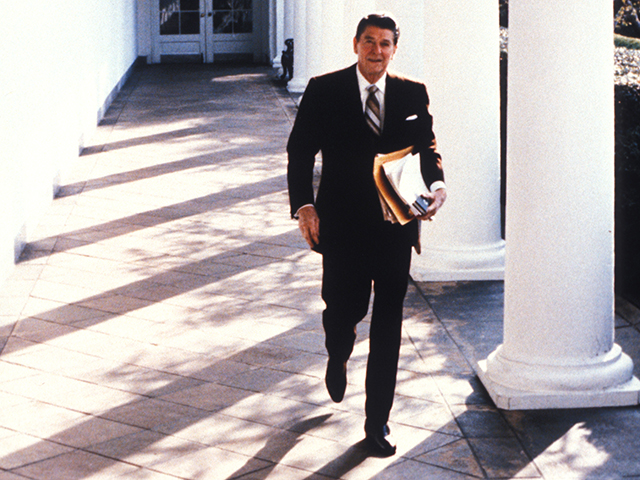What happens to an economy when you do just about everything wrong? Say you spend $830 billion on a stimulus stuffed with make-work government-jobs programs and programs to pay people to buy new cars, you borrow $6 trillion, you launch a government-run health-care system that incentivizes businesses not to hire more workers, you raise tax rates on the businesses that hire workers and on the investors that invest in the businesses that hire workers, you print $3 trillion of paper money, you shut down an entire industry (coal), and try to regulate and restrain the one industry that actually is booming (oil and gas).
We made all of these imbecilic moves, and the wonder of it all is that the U.S. economy is growing at all. It’s a tribute to the indestructible Energizer Bunny that is the entrepreneurial U.S. economy that it keeps going and going even with all the obstacles. The problem is it isn’t going very fast. That’s what the Bureau of Economic Analysis told us this week when it reported that the GDP for the first quarter of the year grew an anemic 0.1 percent on an annual basis from January to March. The more meaningful measure of growth, private-sector GDP, rose by a still-meager 0.2 percent.
Sure, some of the slowdown was a result of lost output due to the severe weather in the Midwest and Northeast. But that might have knocked one percentage point off GDP. Even with that, the growth rate was rotten. The most worrisome sign in the new report was the steep 6 percent annualized drop in private investment spending, which is usually a leading indicator of where the economy is headed. Higher taxes on capital gains and dividends as part of the 2013 Obama tax hike have clearly hurt such investment.
Five years into a recovery, the economy has grown by about 12 percent. That may not sound too bad, but over the first five years of the Reagan recovery, the economy grew 24 percent. Why does this matter? Because if the economy had grown as fast under Obama as it did under Reagan, according to Congress’s bipartisan Joint Economic Committee, the economy would be more than $2 trillion larger today. If that extra $2 trillion were divided evenly among all households, the economy would be about $17,000 bigger per family. Meanwhile, the average family has lost nearly $2,000 in income over this “recovery.”
The Left howls in protest over this comparison. Obama, they claim, inherited a financial crisis that was deeper than anything Reagan ever saw. Obama, by his own admission, saved us from a “second Great Depression,” blah, blah, blah. Of course, the economy really was flat on its back in 2009 when Obama walked into the Oval Office.
But how was that different from 1981? I would say the wreckage that Reagan inherited from Nixon-Ford-Carter might well have been worse: Obama didn’t have to deal with 14 percent inflation, 20 percent mortgage interest rates, an America that was rapidly deindustrializing, and a twelve-year bear market in stocks.
Let’s just accept the proposition that both presidents inherited terrible economic crises. What was different was the policy remedies. Reagan cut tax rates, slashed regulations, trimmed excess money supply (with the help of Fed chairman Paul Volcker), and let the private businesses — the supply side — grow their operations less hindered by government interference.
Obama did, well, pretty much the opposite. At the time of the mighty economic recovery of 2003–09, liberals explained the ferocious burst of growth and employment by saying it was a “classic Keynesian recovery” financed by debt spending. Except if that was the case, why is it that after Obama borrowed twice as much money, this Keynesian recovery has proceeded at half that pace? I’ve never heard an answer to that one. Never.
I’m not saying that the economy would be growing twice as fast and be $2 trillion bigger if Obama had gotten it right. But even if we had had just an average recovery, the economy would be $1.4 trillion larger today. These kinds of counterfactuals are impossible to prove. But it’s a pretty fair bet that things would be a lot better today for middle-class families if we had done Reaganomics, not Obamanomics.
The problem for the Democrats is that the American public doesn’t buy their story and their spin anymore. A majority of voters now say they want a Republican Congress that will block Obama initiatives rather than a Democratic Congress that will rubber-stamp them. It turns out there really is a statute of limitations on blaming Bush for today’s flatlined economy. And the far Left’s counterfactual line is that we should have borrowed even more money to get the economy firing on all cylinders stretches the realm of credibility. How much should we have borrowed? $8 trillion? $10 trillion?
What good that has come from Obamanomics is this: We have hopefully all relearned a painful lesson that government spending, congressional taxing, Treasury borrowing, and Fed printing don’t stimulate the economy. The ideas should be laid to rest and we should all make a solemn pledge to future generations: Never again.
Originally published in National Review Online.




























